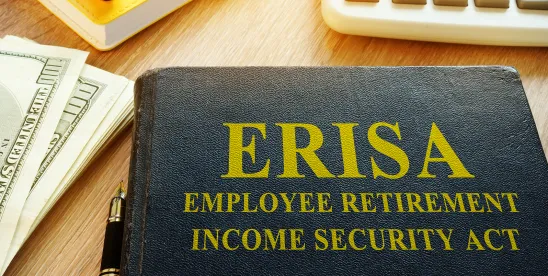Executive employment relationships are rarely permanent. When an executive or other senior-level employee terminates employment, companies often must deal with difficult tax, equity, and benefits issues that arise in the course of the employee’s termination.
This article is the first in a series of articles that will be drafted by Foley & Lardner attorneys over the course of the next five months addressing important compliance pointers for structuring post-termination benefits or addressing issues and considerations for companies when an executive terminates employment. Employers can better position themselves for any termination down the road by thinking through some of these considerations at the start of the executive’s employment arrangement.
To kick off the series, this article focuses on executive severance plans and, in particular, a topic that you may have already considered when drafting an executive severance plan: Will ERISA apply to my executive severance plan? If so, what do I need to know?
This article discusses what constitutes an ERISA-governed executive severance plan, what an ERISA-governed severance plan requires from the plan administrator, and why you may want your plan to be governed by ERISA. We also provide a preview of what is to come in later articles in this series.
Does ERISA Apply to my Executive Severance Plan?
Although they are unusual, funded executive severance plans are always subject to ERISA.
Deciding whether ERISA applies to a more typical unfunded executive severance plan is not as straightforward. The U.S. Supreme Court set the standard for determining whether a severance arrangement is an ERISA plan in 1987. In Fort Halifax Packing Co. v. Coyne, the Court held that an unfunded executive severance plan is likely subject to ERISA if the plan requires an ongoing administrative scheme, specifically noting that a plan providing for a one-time payment triggered by a specific event (like a plant closure) would not be subject to ERISA.
Relying on the Fort Halifax Packing Co. v. Coyne decision, courts have found that an administrative scheme may be established through (i) the exercise of employer discretion, e.g., to decide whether termination is with or without cause, (ii) an ongoing process for complying with a state statute, (iii) an ongoing duty to monitor compliance with non-compete, non-solicitation, and medical coverage provisions, and/or a (iv) group or pattern of similar executive severance agreements.
Most severance plans will afford the employer sufficient discretion to be considered an ERISA-governed plan, even if that was not the employer’s intent. There is nothing wrong with a severance plan being subject to ERISA, but it is important for plan sponsors to be aware of this in order to take advantage of certain benefits that come along with complying with ERISA.
ERISA Applies—What Should I Do?
An ERISA-governed severance plan must be in writing, be administered consistent with the written terms, and comply with the applicable ERISA reporting and disclosure requirements, including annually filing a Form 5500 (if required) and distributing a summary plan description to plan participants. Whether a Form 5500 filing is required depends on several factors, including whether the severance plan is a “pension plan” or “welfare plan” under ERISA. A pension plan under ERISA is any plan, fund, or program established or maintained by an employer that either provides retirement income to employees or results in the deferral of income extending beyond termination. An ERISA welfare plan is any plan, fund, or program established or maintained by an employer that provides a wide range of health or welfare benefits or any benefits as described in Section 302(c) of the Labor Management Relationship Act of 1947, which includes severance. Most severance plans subject to ERISA will qualify as welfare plans. The most likely scenario where a severance plan may qualify as a retirement plan is if severance benefits are only available to employees upon reaching a certain age, such as age 65. Structuring a severance benefit in this way, however, is rare.
If a broad-based severance plan qualifies as a welfare plan (which is most likely), a Form 5500 filing is only required if the plan has 100 or more participants. If a broad-based severance plan qualifies as a pension plan, then a Form 5500 filing is required regardless of how many participants are in the plan.
ERISA also includes claims and appeals procedures that must be followed by the employer and participants in the event of a dispute. This may provide some protection to an employer in the event the employer is sued by a former employee for failing to pay severance benefits. If the employer has followed the claims and appeals procedures, the court will only overturn the employer’s decision if it determines the employer acted in an arbitrary and capricious manner.
Because an executive severance plan is likely limited to a select group of management or highly compensated employees, it may be considered a “top hat” plan. All top hat plans are exempt from certain requirements of ERISA, such as the reporting and disclosure requirements discussed above. This means that a severance plan that qualifies as a top hat welfare plan will not be required to file a Form 5500, regardless of the number of participants in the plan, or distribute a summary plan description. On the rare occasion that a severance plan qualifies as a top hat pension plan, the plan will be exempt from certain other ERISA requirements, provided the plan administrator files a top hat plan statement with the Department of Labor within 120 days of the plan’s effective date. As mentioned before, though, an executive severance plan is not likely to qualify as a pension plan and will only seldomly need to make such a filing with the Department of Labor.
What are the Benefits of an ERISA-Governed Severance Plan?
Being subject to ERISA may confer certain benefits to employers:
- Employees can only sue for benefits and legal fees — no punitive or compensatory damage
- Uniform administration of benefits
- Courts give deference to employer administrative decisions
- Unhappy individuals must exhaust internal claims and appeals procedures of plan before filing suit
- Generally litigated in federal, not state court (which some attorneys prefer)
Anything Else I Should Consider When Drafting an Executive Severance Plan?
Yes, you should consider Internal Revenue Code Section 409A structuring and administration considerations.





 />i
/>i

